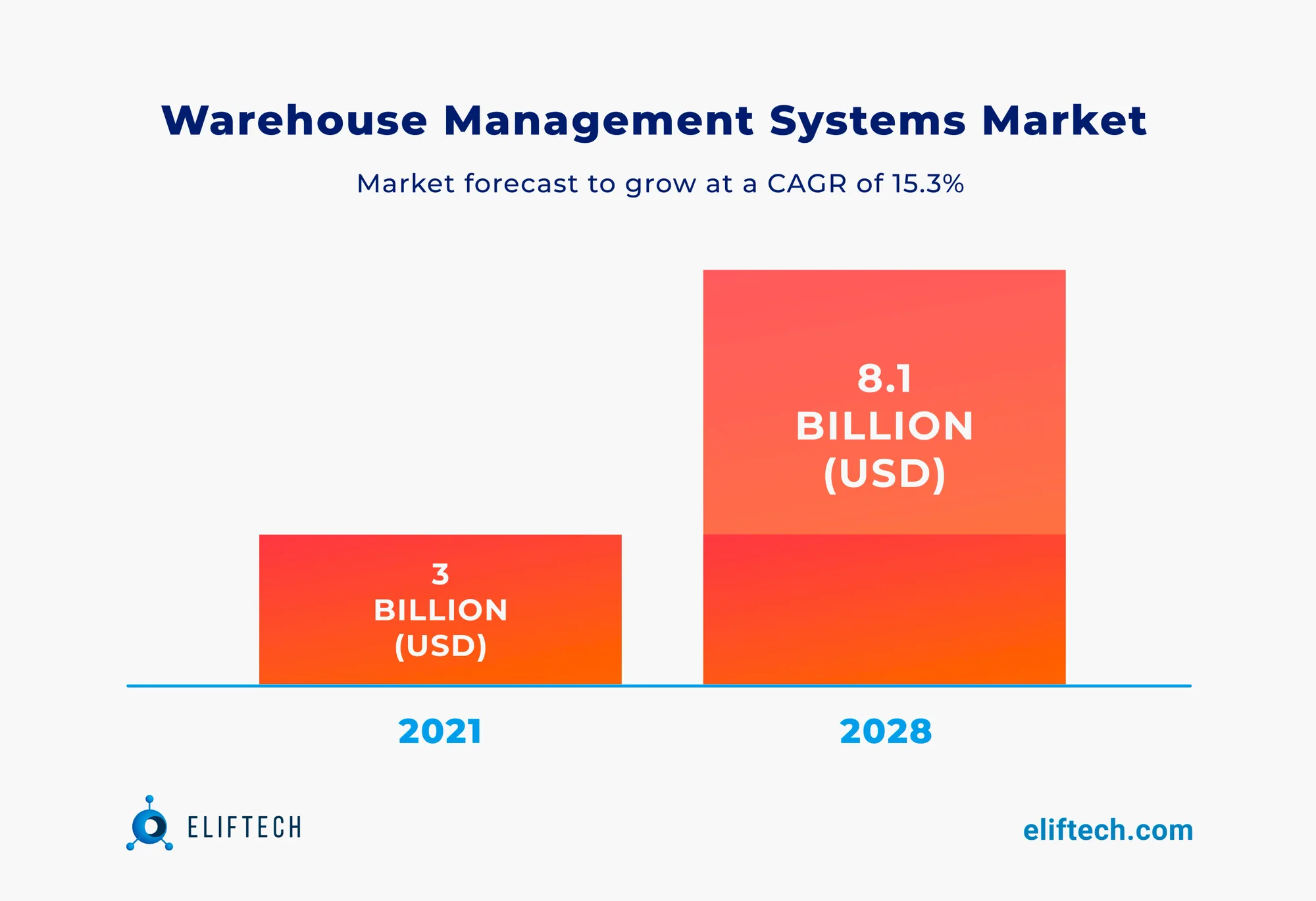Logistics
Full Guide to 3PL Warehouse Management Software: Types, Elements, and Setup

Overstocking, stockouts, poor expandability, low delivery speed, and disappointed customers are all outcomes of traditional inefficient warehouse activities — and this is literally a nightmare for any retailer and e-commerce business today. Given the potential scale of troubles that can arise with inventory at every step of storage, shipping, and distribution — efficient warehouse optimization becomes imperative for businesses navigating through heavy rows of goods.
Smart warehouse management deals with using space, time, and resources more efficiently. This ambitious goal is simply achievable by integrating advanced technologies, such as Internet of Things (IoT) devices, RFID technology, robotics, and barcodes, into smart software systems for efficient storage and management.
This post covers everything you need to know about building 3PL warehouse management software. We explore its core components, must-have features, and required WMS costs and provide insights on tackling the main challenges.
You'll have all your 'what,' 'why,' and 'how' questions answered by the end.
Everything You Want to Know about 3PL Warehouse Management Software in Logistics
As global trade, the e-commerce industry, and the number of global shoppers grow exponentially, logistics and retail businesses face increasing challenges in managing inventories across multiple locations. Even the slightest inefficiencies in warehouse activities can quickly escalate into significant problems, and the potential damage is difficult to predict accurately. As the logistics sector progressively becomes more digitally reliant, businesses running on outdated software are increasingly faced with many challenges that impede operational efficiency and competitiveness.
Inefficiency and inaccuracy: Outdated software often lacks advanced automation features, resulting in significant reliance on manual processes prone to errors. This inefficiency impacts productivity and leads to inaccuracies in data management, hindering decision-making and operational effectiveness.
Limited scalability: As businesses grow, antiquated systems often struggle to cope with increased volumes and the complexities of scaling operations. Their inability to scale effectively hampers growth and can create critical performance bottlenecks.
Lack of real-time insights: Traditional systems typically fail to provide real-time visibility and effective reporting mechanisms, vital for agile decision-making in a fast-paced logistics environment. This deficiency deprives businesses of timely insights for improving operational efficiency and spotting issues before they escalate.
Integration challenges: Outdated software often faces compatibility issues, making integrating with modern systems or technologies difficult. This lack of interoperability complicates data exchange and process alignment across various systems, impairing the company's ability to leverage new technological advancements.
Impact on client satisfaction: Legacy systems can negatively impact customer experiences due to their inability to provide real-time updates, accurate delivery schedules, and efficient handling of customer requests. These gaps can lead to dissatisfaction, causing potential damage to reputation and loss of clientele.
This is a key reason why Warehouse Management System (WMS) software ranks at the top of the list for the most implemented technology, with 84% adoption among Third-Party Logistics Benchmark Report participants. This trend is further supported by market forecasts, which predict significant growth in the WMS market.
For example, the number of cloud-based warehouse management systems is expected to reach a substantial value of $8.1 billion by 2028. This clearly demonstrates the increasing importance and reliance on advanced WMS solutions. These systems are pivotal in efficiently managing modern warehouse operations by providing real-time inventory visibility, enhancing efficiency, ensuring order accuracy, facilitating reporting, optimizing labor productivity, enabling automated billing, and offering various other essential functionalities.

Warehouse Management Systems: Core Capabilities
Warehouse Management Systems (WMS) are sophisticated software solutions that serve as the central nerve center, orchestrating goods' movement, organization, and storage. These systems are prominent in modern warehouse supply chain management, helping e-commerce and other B2B/B2C businesses automate, optimize, and support internal warehouse workflows and processes to improve efficiency, reduce costs, and gain better visibility into all inventory levels.
As mentioned above, its core functions are its robust capabilities that transform traditional warehouses into intelligent and dynamic productivity hubs.
The most demanded warehouse management system features are
- Inventory receiving and storing goods from manufacturers or distributors is a warehouse's main responsibility. Warehouse management systems offer the ability to scan and organize each new item upon its arrival and storage, providing full visibility into received items and their assigned locations.
- Inventory picking and packing — involves selecting the right items from inventory (picking) and preparing them for shipment (packing) using advanced inventory warehouse software technologies like barcodes, RFID tags, or other real-time tracking technologies.
WMS systems offer the valuable capability to generate efficient picking lists, guiding warehouse teams in picking items with maximum efficiency. In addition, if you want to further improve the order fulfillment process, this warehouse inventory management software can automatically generate shipping labels attached to packages after being packed.
- Inventory tracking — provides real-time updates on stock levels, helping you understand how many items are available for sale and whether you should order more based on consumer demand forecasts.
- Shipping and returns — handle shipping and returns with WMS. Delivery progress provides visibility for businesses and customers who value transparency and accuracy in understanding where their goods are. Additionally, WMS automates returns management, providing visibility into returned items and inventory adjustments for better customer satisfaction.
- Reporting and real-time analytics — allows businesses to generate custom reports, track key performance indicators (KPIs), and gain valuable insights into warehouse performance. Managers can use this data to identify trends and bottlenecks, forecast demand, optimize picking routes, and improve inventory accuracy.
- Scaling capabilities — allows to expand and change operations without suffering significant disruptions. As companies grow or experience fluctuating demand for dozens of goods and different product types, a scalable WMS can easily adapt to these changes. Additionally, by creating a system from scratch, you may build in the required level of scalability in terms of the number of employees, warehouses, and other factors.
- Automation and robotics — includes modern technologies like robots and automated guided vehicles (AGVs) to move goods throughout the warehouse. As a result, warehouse automation software demands less human interaction, which increases work efficiency.
- Labor management tools — monitor worker efficiency, productivity, and performance, offering insights into individuals’ as well as team performance. Businesses use this data to pinpoint areas for improvement, allocate resources more effectively, and boost employee efficiency.
- Multi-location support — offers seamless support for controlling and coordinating activities across multiple warehouse locations. This feature enables efficient inventory transfers, stock level balancing, and high-level optimization of distribution strategies.
- Integrations with other business systems — provide a panoramic view of your supply chain. Integrations with ERP, TMS, SCM, and even billing systems ensure accurate inventory tracking, optimized transportation routes, and smooth billing processes, enhancing overall logistics efficiency and customer service.
Types of Warehouse Management Systems
Comprehending the diversity of warehousing solutions available to integrate WMS software for boosting warehouse logistics operations is essential. Depending on their functionalities, WMS software can be grouped into five categories detailed below.
Standalone WMS
As suggested by their moniker, standalone warehouse management systems are independent, feature-loaded software engineered principally to optimize warehouse logistics operations. Their functionality is fairly restricted when it comes to other supply chain warehousing tasks such as distribution, finance, and customer service. These systems, being on-premise, work alongside a warehouse's hardware and network.
Ideal for:
Small businesses are the perfect fit for a standalone WMS, given the affordability and availability of basic features such as barcode scanning, put away, receiving, picking, packing, shipping, slotting, cycle counting, etc. Often, smaller businesses use standalone WMS software as an inventory management system. Advanced reporting capabilities enable these businesses to elevate their warehousing operations.
ERP-Based WMS
An ERP-based WMS amalgamates scalability, supply chain management, and core applications that help retailers and 3PL firms operate smoothly. Core applications within an ERP-based WMS include accounting, human resource management, supply chain management, customer relationship management, etc. This system centralizes warehouse logistics operations in one interface.
It offers detailed insight across the logistics chain while maintaining transparency for synchronized execution and orchestration of logistic and warehouse processes. These tools are optimal for operations while offering agile and fast fulfillment experiences.
Ideal for:
Retailers looking for scalable software solutions on a grander scale will find ERP-based WMS systems favorable. It has the potential to boost competitiveness and improve ROI through robust scalability and supply chain management. Firms seeking to consolidate their software into one platform will find ERP warehousing services most fitting.
Cloud-Based WMS
Harnessing cloud technology, cloud-based WMS operates as a centralized and web-based computing platform. Offered as Software as a Service (SaaS), it is renowned for its swift deployment, scalability, and reduced IT maintenance, courtesy of its cloud server hosting.
This system is highly adaptable to the warehouse environment, thus enhancing productivity irrespective of volume, complexity, and operational size. Users of this WMS software effortlessly receive free updates, which bolsters technological competitiveness.
Ideal for:
Retailers operating warehouses in multiple locations will find cloud-based WMS most beneficial as it provides flexibility and compatibility. Expanding businesses can adeptly use cloud-based WMS since it can adjust along with the business growth and enables the procurement of more licenses whenever required.
Small to medium enterprises find cloud-based WMS software ideal due to its user-friendly interface, scalability, and flexible pricing. It impels supply chain managers to focus more on customer experience and tracking real-time performance. This guarantees data security, making it highly favored among retailers.
Supply Chain Execution Module
The supply chain execution module WMS is a sophisticated system that manages diverse aspects of supply chain warehousing management by robotizing tasks like product cycles, sourcing materials, and inventory management. It also plays an integral part in managing vendor relationships, risk assessments, and ongoing business processes. It facilitates the exploration of multiple benefits of supply chain management for 3PL firms while streamlining them.
Ideal for:
A supply chain module warehousing solution is perfect for growing or established organizations fully utilizing the dimensions of supply chain management. These companies can couple the Supply Chain Module with other applications for a cohesive warehouse experience. It streamlines and enhances the entire process of supply chain warehousing.
On-Premise WMS
On-premise WMS solutions are software that operates on-site using the warehouse's server. This WMS solution optimizes specific warehouse logistics workflows managed by a company's IT department and other internal support teams. This warehousing solution ensures a higher control over operations, which is highly sought after by many organizations.
On-Premises vs. Cloud-Based: Which is Right for You?
The initial versions of warehouse management systems were predominantly on-premises. The advent of on-prem WMS software marked a significant innovation milestone. However, newer developments have gravitated more towards cloud-based automated warehouse software development due to its superior scalability and accessibility, notably the capacity to broadcast real-time data across multiple sites. Markets and Markets' Warehouse Management System Market Global Forecast to 2025 published found that:
On-premises WMS is expected to grow 13.1% through 2025, while cloud-based WMS is expected to grow at 28.7% through 2025.
Benefits of On-Premises WMS
A substantial advantage of an on-premises WMS is the comprehensive control it affords businesses over their operations. With an on-premises arrangement, the system can be configured and personalized according to specific needs, offering increased flexibility for handling workflows and accessing data. Additionally, the on-prem model eliminates concerns about subscription fees or reoccurring service costs, as the software is locally installed, with expenditures predominantly tied to the initial purchase price. However, this frequently necessitates the presence of an internal IT support team and possibly more servers for backup. Upgrades can also be expensive as each update may involve additional costs and prolonged implementation time.
Concerning security, on-premise solutions stand out. Since all data and systems reside locally within your organization's network, the likelihood of unauthorized access to sensitive information or intellectual property is reduced. This heightened security is crucial for businesses operating within regulated sectors like healthcare or finance, where security factors are prominent.
In sum, if you desire complete control over your WMS operations and the scope to fine-tune your system to align with defined needs, an on-premise solution might be your preferred choice. However, weighing the related costs and implementation complexities is essential before deciding. For most businesses, the clear preference is for a cloud-based WMS.
Why is a Cloud-Based WMS Better Than On-Premises?
Cloud-based Warehouse Management Systems (WMS) often have advantages over on-premises solutions, making them a better choice for many businesses. Here are a few reasons:
Higher visibility: A cloud-based WMS enables a comprehensive view of all operational aspects, empowering you to surpass customer expectations. Employing a cloud-based WMS allows your 3PL to manage its operations more effectively, responding promptly to the dynamic market demands. Furthermore, you can accomplish all this using a unified platform, simplifying the organization and boosting efficiency.
Increased savings: Trim down operational expenses, encompassing installation and maintenance, manpower, and inefficiencies-related costs. A cloud-based WMS can aid in superior time management, allow for improved resource monitoring, and liberate your team for advanced tasks. The appropriate 3PL WMS can precisely track inventory, create packing lists, send alerts to customers, and assist in labor management. This can enhance your savings while optimizing your efficiency.
Scalability and Accessibility: Cloud-based WMS provides better scalability and accessibility. Such systems can work on a wide range of devices without needing new hardware purchases if your equipment meets the initial requirements. This attribute means multiple users can use the software from various locations, making real-time data distribution possible across multiple locations.
Cost and maintenance: The cost and maintenance factors also stand out. Unlike on-premise solutions, where there are significant upfront costs along with ongoing maintenance and upgrade costs, cloud-based solutions usually operate on a subscription model. These can be more cost-effective in the long run as you only pay for what you use and require less in-house IT infrastructure and team.
Unlimited Computing Power: Cloud-based solutions can leverage potentially unlimited computing power available in the cloud, permitting smooth simultaneous processing of many transactions.
In short, a cloud-based WMS could offer more flexibility, cost-effectiveness, and scalability compared to an on-premises solution. However, the choice between the two should ultimately be based on your business needs and circumstances.
5 Challenges in WMS Development and How to Solve Them
Although any Warehouse Management System (WMS) can offer you multiple advantages, it will come with its share of challenges. To ensure a successful implementation, it's vital to recognize and overcome these challenges beforehand.
Challenge #1. WMS integrations with legacy systems.
Retail and logistics companies often have existing systems in place (e.g., ERP and CRM solutions, transportation management systems, accounting solutions, data analytics, and business intelligence tools) that need to be integrated with new 3PL warehouse software modules. Keeping old and new systems compatible can be a significant technical challenge.
Advice from our team: Using APIs and microservices architecture makes communication and legacy systems seamless. As a result, current systems no longer need to be replaced entirely for a new application to communicate with them.
Challenge #2. User acceptance.
For drivers and employees to quickly use warehouse apps, they need to be easy to use and intuitive. Your employees need convenient web and mobile interfaces to access, manage, and analyze visually appealing and intuitive data.
Advice from our team: Conducting in-depth user research and creating user-centric interfaces can improve user experience and increase adoption. Regular user testing and feedback analysis can also enhance the logistics warehouse management app design.
At ElifTech, we are well-versed in applying user-friendly and well-tested design practices. Look at our design service offerings to know what you will get.
Challenge #3. Real-time data accuracy and processing.
Developing mechanisms to capture and update data accurately in real-time, such as by using barcodes, RFID, or IoT devices, can be a challenge. So, it’s crucial to establish efficient data validation procedures, ensure data integrity, and reduce data duplication.
Advice from our team: Real-time data processing can be possible with scalable systems and cloud-based solutions. By doing this, the warehouse inventory app can handle increasing amounts of data without downtime or system crashes.
Challenge #5. Customization and flexibility.
Customization and system adaptability might be challenging to balance. While limited customization could result in a poor solution, excessive customization might increase development time, expenses, and maintenance complexity.
Advice from our team: Establish a roadmap on customization early in the development phase. Prioritize the most critical business requirements and think about developing separate modules to support future customization while maintaining system agility.
The Power of Custom Logistic Warehouse Management Software
At ElifTech, we develop custom 3PL WMS software that aligns precisely with a company's operational workflows, inventory management needs, and specific industry demands. From real-time inventory tracking to detailed reporting and forecasting, our WMS offers advanced features to provide comprehensive control over your warehouse operations.
With ElifTech by your side, you gain access to a team of dedicated professionals adept at turning your vision into reality. From order processing and inventory management to real-time analytics and reporting, we build 3PL warehouse management software solutions to integrate into your company's environment. Along with providing a high-quality software solution, we offer robust tech support and regular maintenance, ensuring your system performs optimally.
Tell us about your needs, and we’ll consult you on the best solution. The key is not just to manage but to strategically orchestrate warehouse operations to bring in efficiency, smooth functionality, customer satisfaction, and ultimately business growth. And that's precisely what ElifTech aims to deliver through its custom 3PL WMS.
